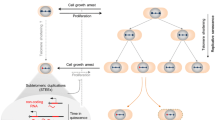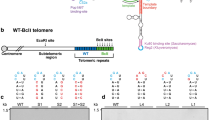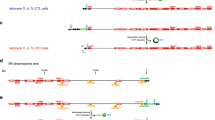Abstract
ATM/ATR homologs are the central elements of genome surveillance mechanisms in many organisms, including yeasts, flies, and mammals. In Saccharomyces cerevisiae, most checkpoint responses depend on the ATR ortholog Mec1p. The yeast ATM ortholog, Tel1p, so far has been implicated in a specific DNA damage checkpoint during S-phase as well as in telomere homeostasis. In particular, yeast cells lacking only Tel1p harbor short but stable telomeres, while cells lacking both Tel1p and Mec1p are unable to maintain telomeric repeats and senesce. Here, we present the characterization of a new mutation in the TEL1-gene, called tel1-11, which was isolated by virtue of a synthetic lethal interaction at 37°C with a previously described mec1-ts mutation. Interestingly, telomere and checkpoint functions are differentially affected by the mutant protein Tel1-11p. The Tel1p-dependent checkpoint response is undetectable in cells containing Tel1-11p and incubated at 37°C, but basic telomere function is maintained. Further, when the same cells are incubated at 26°C, Tel1-11p confers full proficiency for all telomere functions analyzed, whereas the function for DNA-damage checkpoint activation is clearly affected. The results thus strongly suggest that the different cellular pathways affected by Tel1p do not require the same level of Tel1p activity to be fully functional.







Similar content being viewed by others
References
Bosotti R, Isacchi A, Sonnhammer EL (2000) FAT: a novel domain in PIK-related kinases. Trends Biochem Sci 25:225–227
Brachmann CB et al (1998) Designer deletion strains derived from Saccharomyces cerevisiae S288C: a useful set of strains and plasmids for PCR-mediated gene disruption and other applications. Yeast 14:115–132
Cha RS, Kleckner N (2002) ATR homolog Mec1 promotes fork progression, thus averting breaks in replication slow zones. Science 297:602–606
Chakhparonian M, Wellinger RJ (2003) Telomere maintenance and DNA replication: how closely are these two connected? Trends Genet 19:439–446
Chamankhah M, Fontanie T, Xiao W (2000) The Saccharomyces cerevisiae mre11(ts) allele confers a separation of DNA repair and telomere maintenance functions. Genetics 155:569–576
Chan SW, Blackburn EH (2003) Telomerase and ATM/Tel1p protect telomeres from nonhomologous end joining. Mol Cell 11:1379–1387
Chan SW, Chang J, Prescott J, Blackburn EH (2001) Altering telomere structure allows telomerase to act in yeast lacking ATM kinases. Curr Biol 11:1240–1250
Clerici M, Paciotti V, Baldo V, Romano M, Lucchini G, Longhese MP (2001) Hyperactivation of the yeast DNA damage checkpoint by TEL1 and DDC2 overexpression. Embo J 20:6485–6498
Corda Y et al (1999) Interaction between Set1p and checkpoint protein Mec3p in DNA repair and telomere functions. Nat Genet 21:204–208
D’Amours D, Jackson SP (2001) The yeast Xrs2 complex functions in S phase checkpoint regulation. Genes Dev 15:2238–2249
D’Amours D, Jackson SP (2002) The mre11 complex: at the crossroads of dna repair and checkpoint signalling. Nat Rev Mol Cell Biol 3:317–327
Giannattasio M et al (2002) A dominant-negative MEC3 mutant uncovers new functions for the Rad17 complex and Tel1. Proc Natl Acad Sci USA 99:12997–13002
Gietz RD, Schiestl RH, Willems AR, Woods RA (1995) Studies on the transformation of intact yeast cells by the LiAc/SS-DNA/PEG procedure. Yeast 11:355–360
Goldstein AL, McCusker JH (1999) Three new dominant drug resistance cassettes for gene disruption in Saccharomyces cerevisiae. Yeast 15:1541–1553
Greenwell PW, Kronmal SL, Porter SE, Gassenhuber J, Obermaier B, Petes TD (1995) TEL1, a gene involved in controlling telomere length in S. cerevisiae, is homologous to the human ataxia telangiectasia gene. Cell 82:823–829
Kranz JE, Holm C (1990) Cloning by function: an alternative approach for identifying yeast homologs of genes from other organisms. Proc Natl Acad Sci USA 87:6629–6633
Lisby M, Barlow JH, Burgess RC, Rothstein R (2004) Choreography of the DNA damage response: spatiotemporal relationships among checkpoint and repair proteins. Cell 118:699–713
Longhese MP, Paciotti V, Neecke H, Lucchini G (2000) Checkpoint proteins influence telomeric silencing and length maintenance in budding yeast. Genetics 155:1577–1591
Lundblad V, Blackburn EH (1993) An alternative pathway for yeast telomere maintenance rescues est1-senescence. Cell 73:347–360
Lundblad V, Szostak JW (1989) A mutant with a defect in telomere elongation leads to senescence in yeast. Cell 57:633–643
Lustig AJ, Petes TD (1986) Identification of yeast mutants with altered telomere structure. Proc Natl Acad Sci USA 83:1398–1402
McAinsh AD, Scott-Drew S, Murray JA, Jackson SP (1999) DNA damage triggers disruption of telomeric silencing and Mec1p-dependent relocation of Sir3p. Curr Biol 9:963–966
Metcalfe JA et al (1996) Accelerated telomere shortening in ataxia telangiectasia. Nat Genet 13:350–353
Mieczkowski PA, Mieczkowska JO, Dominska M, Petes TD (2003) Genetic regulation of telomere-telomere fusions in the yeast Saccharomyces cerevisae. Proc Natl Acad Sci USA 100:10854–10859
Morrow DM, Tagle DA, Shiloh Y, Collins FS, Hieter P (1995) TEL1, an S. cerevisiae homolog of the human gene mutated in ataxia telangiectasia, is functionally related to the yeast checkpoint gene MEC1. Cell 82:831–840
Myung K, Chen C, Kolodner RD (2001) Multiple pathways cooperate in the suppression of genome instability in Saccharomyces cerevisiae. Nature 411:1073–1076
Nakada D, Matsumoto K, Sugimoto K (2003a) ATM-related Tel1 associates with double-strand breaks through an Xrs2-dependent mechanism. Genes Dev 17:1957–1962
Nakada D, Shimomura T, Matsumoto K, Sugimoto K (2003b) The ATM-related Tel1 protein of Saccharomyces cerevisiae controls a checkpoint response following phleomycin treatment. Nucleic Acids Res 31:1715–1724
Nyberg KA, Michelson RJ, Putnam CW, Weinert TA (2002) Toward maintaining the genome: DNA damage and replication checkpoints. Annu Rev Genet 36:617–656
Pandita TK (2002) ATM function and telomere stability. Oncogene 21:611–618
Ritchie KB, Petes TD (2000) The Mre11p/Rad50p/Xrs2p complex and the Tel1p function in a single pathway for telomere maintenance in yeast. Genetics 155:475–479
Ritchie KB, Mallory JC, Petes TD (1999) Interactions of TLC1 (which encodes the RNA subunit of telomerase), TEL1, and MEC1 in regulating telomere length in the yeast Saccharomyces cerevisiae. Mol Cell Biol 19:6065–6075
Rose MD, Winston F, Hieter P (1990) Methods in yeast genetics: a laboratory course manual. Cold Springs Harbor Laboratory Press, Cold Spring Harbor
Sambrook J, Fritsch EF, Maniatis T (1989) Molecular cloning: a laboratory manual, 2 edn. Cold Spring Harbor Laboratory Press, Cold Spring Harbor
Sanchez Y, Desany BA, Jones WJ, Liu Q, Wang B, Elledge SJ (1996) Regulation of RAD53 by the ATM-like kinases MEC1 and TEL1 in yeast cell cycle checkpoint pathways. Science 271:357–360
Santocanale C, Diffley JF (1998) A Mec1- and Rad53-dependent checkpoint controls late-firing origins of DNA replication. Nature 395:615–618
Sikorski RS, Hieter P (1989) A system of shuttle vectors and yeast host strains designed for efficient manipulation of DNA in Saccharomyces cerevisiae. Genetics 122:19–27
Takata H, Kanoh Y, Gunge N, Shirahige K, Matsuura A (2004) Reciprocal association of the budding yeast ATM-related proteins Tel1 and Mec1 with telomeres in vivo. Mol Cell 14:515–522
Takata H, Tanaka Y, Matsuura A (2005) Late S phase-specific recruitment of Mre11 complex triggers hierarchical assembly of telomere replication proteins in Saccharomyces cerevisiae. Mol Cell 17:573–583
Teng SC, Zakian VA (1999) Telomere-telomere recombination is an efficient bypass pathway for telomere maintenance in Saccharomyces cerevisiae. Mol Cell Biol 19:8083–8093
Tsukamoto Y, Taggart AK, Zakian VA (2001) The role of the Mre11-Rad50-Xrs2 complex in telomerase- mediated lengthening of Saccharomyces cerevisiae telomeres. Curr Biol 11:1328–1335
Usui T, Ogawa H, Petrini JH (2001) A DNA damage response pathway controlled by Tel1 and the Mre11 complex. Mol Cell 7:1255–1266
Vialard JE, Gilbert CS, Green CM, Lowndes NF (1998) The budding yeast Rad9 checkpoint protein is subjected to Mec1/Tel1-dependent hyperphosphorylation and interacts with Rad53 after DNA damage. Embo J 17:5679–5688
Weinert TA, Kiser GL, Hartwell LH (1994) Mitotic checkpoint genes in budding yeast and the dependence of mitosis on DNA replication and repair. Genes Dev 8:652–665
Wellinger RJ, Wolf AJ, Zakian VA (1993) Origin activation and formation of single-strand TG1–3 tails occur sequentially in late S phase on a yeast linear plasmid. Mol Cell Biol 13:4057–4065
Wong KK et al (2003) Telomere dysfunction and Atm deficiency compromises organ homeostasis and accelerates ageing. Nature 421:643–648
Zakian VA, Scott JF (1982) Construction, replication, and chromatin structure of TRP1 RI circle, a multiple-copy synthetic plasmid derived from Saccharomyces cerevisiae chromosomal DNA. Mol Cell Biol 2:221–232
Zhao X, Muller EG, Rothstein R (1998) A suppressor of two essential checkpoint genes identifies a novel protein that negatively affects dNTP pools. Mol Cell 2:329–340
Zhu Y, Xiao W (2001) Two alternative cell cycle checkpoint pathways differentially control DNA damage-dependent induction of MAG1 and DDI1 expression in yeast. Mol Genet Genomics 266:436–444
Acknowledgements
We thank R. Rothstein, D. Durocher, T. Weinert, and M. -P. Longhese for generously providing yeast strains, plasmid constructs, or antibodies used in this study. This project was actually initiated by I. Dionne, whom we thank for providing unpublished data. The work was supported by the Canadian Cancer Society (NCIC research grant 013235). M. C. was supported by a postdoctoral fellowship by the Swiss National Science Fund and R. J. W. is a Chercheur National from the FRSQ.
Author information
Authors and Affiliations
Corresponding author
Additional information
Communicated by S. Hohmann
Electronic supplementary material
Rights and permissions
About this article
Cite this article
Chakhparonian, M., Faucher, D. & Wellinger, R.J. A mutation in yeast Tel1p that causes differential effects on the DNA damage checkpoint and telomere maintenance. Curr Genet 48, 310–322 (2005). https://doi.org/10.1007/s00294-005-0020-7
Received:
Revised:
Accepted:
Published:
Issue Date:
DOI: https://doi.org/10.1007/s00294-005-0020-7




